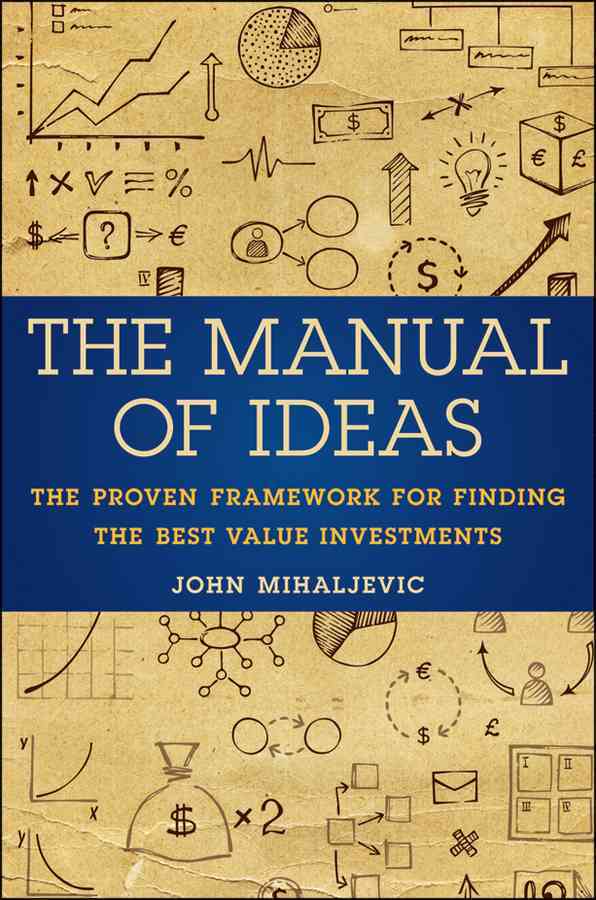 I’m a value investor, and one that is not doctrinaire about a narrow set of principles.? Yes, I like my eight rules, but they are broad principles that admit a lot of flexibility.
I’m a value investor, and one that is not doctrinaire about a narrow set of principles.? Yes, I like my eight rules, but they are broad principles that admit a lot of flexibility.
The Manual of Ideas introduces readers to a wide number of ways to source investing ideas that may offer value.? There are nine main areas that they highlight:
1) One can invest in a small number of stocks that are worth more dead than alive.? Net-net stocks show places where the downside is minimal, and profits could be made if either the company turns around or liquidates.
2) Sometimes companies obscure their value because they do multiple things.? The company would be more valuable broken into its constituent parts, which would get a higher? valuation in aggregate.
3) You can follow the magic formula, and buy stocks that have high returns on equity and low P/E ratios.
4) You can own stocks managed by talented managers, and I admit that maybe 7 of the 37 stocks I hold fall into that bucket, and I will not readily sell them.? The question is how you find those managers.? That’s not easy, and involves industry knowledge which is not available to all.
5) You can own stocks owned by smart investors, and I admit that I track this every quarter.? I get a lot of good ideas from them, but I like to look at the ideas that are cold, because they offer more potential.
6) Buy teensy stocks that no one follows, that are making money and have legitimate business models.? You can’t put a lot of money to work that way, but if you get it right, it can add value.
7) Buy companies that are undergoing a structural change that adds value.? Example: a petroleum refiner decides to spin off a pipeline Master Limited Partnership.
8 ) Buy highly indebted companies that offer the potential of huge gains if the idea works out.? Screen out companies that are more likely to lose it all.
9) Buy international companies — the scrutiny and competition are less — you may find something genuinely cheap, but make sure they play fair with outside passive minority shareholders.
There are some very good methods here, but what should you decide to pursue?? That is the one weakness of the book.? The book gives you a significant but not exhaustive tour of the ideas behind value investing.? What would have added a lot is an integrated chapter on when it is best to pursue each set of ideas. It is difficult enough for professional investors to know which method is best at a given time, much less amateurs.? The time of investors, both professional and amateur, is limited.? It would be a great aid to figure out how to prioritize the methods or ideas.
Also, more emphasis on margin of safety would have been useful.? We can never get too much of that.
But I would recommend this book strongly to all investors.? It will strengthen your idea generation processes.
Quibbles
Already expressed.
Who would benefit from this book: Most investors would benefit from reading this book.? It will aid them in idea generation.? If you want to, you can buy it here: The Manual of Ideas: The Proven Framework for Finding the Best Value Investments.
Full disclosure: The publisher sent me the book after asking me if I wanted it.
If you enter Amazon through my site, and you buy anything, I get a small commission.? This is my main source of blog revenue.? I prefer this to a ?tip jar? because I want you to get something you want, rather than merely giving me a tip.? Book reviews take time, particularly with the reading, which most book reviewers don?t do in full, and I typically do. (When I don?t, I mention that I scanned the book.? Also, I never use the data that the PR flacks send out.)
Most people buying at Amazon do not enter via a referring website.? Thus Amazon builds an extra 1-3% into the prices to all buyers to compensate for the commissions given to the minority that come through referring sites.? Whether you buy at Amazon directly or enter via my site, your prices don?t change.

This was probably one of the best content books I have read over the past few years. I has more ideas and places to get ideas than I have seen thusfar. You are correct that there is no guide to when is the best time to use each strategy but I think Chapter 1 lays out that each investor is an individual and will have to determine which strategy works best for them at what time. The one strategy I think they lay out that is not discussed much is the stub stock strategy. This is how large amounts of wealth has been generated (and sometimes lost) in real estate, telco and media firms over relatively short periods of time. If you can deal with the volatility and develop a margin of safety via credit analysis, this can be a great area to invest. You can find examples of strategies and how they are played out via message boards such as the Corner of Berkshire and Fairfax. Look in the strategies section and as an example the FRE/FNM preferred thread.
Packer